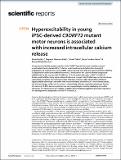Hyperexcitability in young iPSC-derived C9ORF72 mutant motor neurons is associated with increased intracellular calcium release
Abstract
A large hexanucleotide repeat expansion in the C9ORF72 gene is the most prevalent cause of amyotrophic lateral sclerosis (ALS). To better understand neuronal dysfunction during ALS progression, we studied motor neuron (MN) cultures derived from iPSC lines generated from C9ORF72 (C9) expansion carriers and unaffected controls. C9 and control MN cultures showed comparable mRNA levels for MN markers SMI-32, HB9 and ISL1 and similar MN yields (> 50% TUJ1/SMI-32 double-positive MNs). Using whole-cell patch clamp we showed that C9-MNs have normal membrane capacitance, resistance and resting potential. However, immature (day 40) C9-MNs exhibited a hyperexcitable phenotype concurrent with increased release of calcium (Ca2+) from internal stores, but with no changes to NaV and KV currents. Interestingly, this was a transient phenotype. By day 47, maturing C9-MNs demonstrated normal electrophysiological activity, displaying only subtle alterations on mitochondrial Ca2+ release. Together, these findings suggest the potential importance of a developmental component to C9ORF72-related ALS.
Citation
Burley , S , Beccano-Kelly , D A , Talbot , K , Cordero Llana , O & Wade-Martins , R 2022 , ' Hyperexcitability in young iPSC-derived C9ORF72 mutant motor neurons is associated with increased intracellular calcium release ' , Scientific Reports , vol. 12 , 7378 . https://doi.org/10.1038/s41598-022-09751-3
Publication
Scientific Reports
Status
Peer reviewed
ISSN
2045-2322Type
Journal article
Description
S.B. was supported by a Motor Neuron Disease Association studentship (WadeMartins/Oct13/867-792) and D.A.B was supported by the Monument Trust Discovery Award (J-1403) from Parkinson’s UK. The work was supported by the Medical Research Council Dementias Platform UK Stem Cell Network (Grant MR/M024962/1 to RW-M).Collections
Items in the St Andrews Research Repository are protected by copyright, with all rights reserved, unless otherwise indicated.

